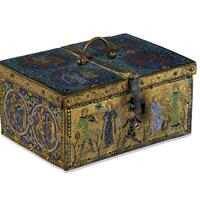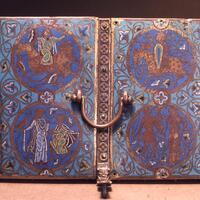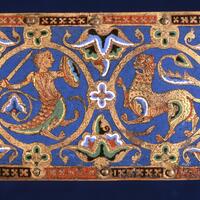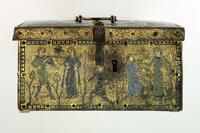Troubadour Casket
Type:
Boxes
Date:
ca. 1180
Location or Findspot (Modern-Day Country):
France
Dimensions:
11.6 × 21.7 × 6.5 cm
Description:
This small box is the earliest surviving product of the Limoges enamel workshops that has entirely secular iconography. On the front, a patterned gold ground that suggests a luxurious garden sets off the lively figures of two pairs of lovers. The man and woman on the left are making music and dancing, which has inspired the name of the box (troubadours were singers of romantic lyrics). Between them, a bird represents the man's love or his song. At the right, a man submits to a woman, who binds him with the leash of the falcon she holds in her hand. The man's pose is that of a vassal submitting to his lord. Under the latch, between the two couples, a mysterious figure holds a large key and a sword. Is he protecting the contents of the box? Is he a jealous husband spying on an errant wife?
The top and sides of the casket feature paired medallions enclosing human and animal figures, including a knight attacked by a lion and a lady with a hawk. These scenes of love, music, and combat—drawn from real and imagined courtly life—were popular in European arts from the twelfth century on. Because the box lacks imagery that could tie it to a specific patron, it was probably made for a larger, nonspecific market.
The top and sides of the casket feature paired medallions enclosing human and animal figures, including a knight attacked by a lion and a lady with a hawk. These scenes of love, music, and combat—drawn from real and imagined courtly life—were popular in European arts from the twelfth century on. Because the box lacks imagery that could tie it to a specific patron, it was probably made for a larger, nonspecific market.
Relevant Textbook Chapter(s):
8
Repository and Online Resources:
• The Troubadour Casket is in the British Museum, London.
• Zoom in on the casket here.
Image Credits:
© The Trustees of the British Museum





